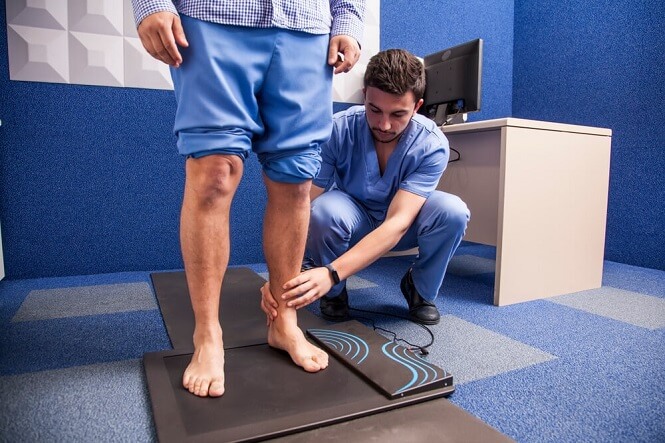Podiatry and chiropody both refer to the discipline related to ankle and foot wellness. Both these terms are heard when we talk about the wellbeing of our foot health. But are podiatry and chiropody the same thing? If not, then what is the difference between a podiatrist and a chiropodist?
Read on to find out the answer to it. And make yourself familiar with the concept of podiatry and chiropody.
Table of Contents
What Are Podiatry And Chiropody?
Podiatry or podiatry medicine is a speciality of medicine. It focuses on the research and diagnosis of foot disorders. Moreover, medical and surgical treatment of the ankle is a major aspect of podiatry. Also, podiatrists need to study and examine lower extremity diseases. The term podiatry was first used in the United States in the early twentieth century. And it is now used all over the world, including in the United Kingdom, Australia, and Canada. Many nations recognise podiatry as a speciality.
However, some physicians in English-speaking nations may refer to themselves as chiropodists. Chiropody is a regulated healthcare profession. It concerns the evaluation and treatment of foot and foot-related problems. Treatment options include medical, surgical, and palliative care.
What is the Difference Between a Podiatrist and a Chiropodist?
Now that we know what podiatry and chiropody are, let’s figure out the difference between the two. So, what is the difference between a chiropodist and a podiatrist? There are no visible differences between a chiropodist and a podiatrist. Both medical professionals work in the same branch of the field.

However, chiropodist is a popular term used in the UK. It essentially designates a podiatrist. Chiropodists are foot specialists. They specialise in treating persons with lower limb or common foot ailments. Such examples include bunions and ingrown toenails.
The role of these foot doctors is to advise patients on how to take care of their feet. Whether they are podiatrists or chiropodists, they heed you on what type of shoes you should wear.
Foot disorders can be treated and alleviated by podiatrists and chiropodists. Disorders include fungal or ingrown toenails. Furthermore, they can treat calluses and corns, verrucas, and smelly feet. Podiatrists can also treat cracked heels and athlete’s feet. People with diabetic foot ulcers and diabetic feet can also benefit from the services of podiatrists and chiropodists.
A podiatrist or chiropodist spends 1000 hours on clinically supervised training. The law protects the profession of podiatry and chiropody. The Health and Care Professions Council requires those who use protected titles to register.
You need a bachelor’s degree from one of the UK’s 13 accredited podiatry schools. And then you will be eligible for registration. Moreover, Health Profession Council recognises some professional groups and institutions. It includes
- The Institute of Chiropodists and Podiatrists
- The British Chiropody and Podiatry Association
- The Society of Chiropodists and Podiatrists
- The Alliance of Private Sector Practitioners
You can register with any of these institutes to become an eligible chiropodist.
Frequently Asked Questions (FAQ) About Chiropodist & Podiatrist
You might need answers to a few questions before you book your chiropodist appointment. We are here to help you with that. Here is a list of comprehensive answers to questions you might want to be in the know of. The list will air out any confusion you might have before your visit to a chiropodist clinic.
A few typical questions include the following –
Is A Podiatrist Considered A Physician?
A podiatrist or chiropodist is sometimes referred to as a “foot doctor”. However, they are not physicians with medical licences. But, a podiatrist is an expert in the field of feet and foot care. We know that podiatry and chiropody are essentially the same lines of practice. Hence, a chiropodist holds the same designation as a podiatrist. The name may be interchanged depending upon the region.

A podiatrist and a chiropodist have the same qualification and experience. Both will provide you with the same treatment and advice. They have a Chiropody post-secondary credential. Furthermore, they may have a bachelor’s degree or university-level education in the sciences.
Some practitioners also enrol on extra education and training. If you are interested in learning more, you can check the ‘Podiatry Training Course’ by One Education to get a well-rounded idea.
However, it would be best if you did not confuse podiatrists with medical doctors. Regardless, some podiatrists argue that they go through seven years of extensive training. And then they can become a podiatrist surgeon. Moreover, they are highly knowledgeable regarding human anatomy.
They study the human body like other medical students. Also, they need a licence to practice as a qualified podiatrist. In place of these reasons, one might deem a podiatrist as a highly trained medical professional.
What Treatments Do Chiropodists Offer?
A Chiropodist is a primary health care provider. They focus on the diagnosis, treatment, and prevention of foot dysfunctions. A chiropodist is concerned with illnesses and diseases related to foot health. Besides, chiropodists have experience in the therapy of acute and chronic foot disorders. Hence, they are a vital member of the multidisciplinary health care team.

Some examples of treatments Chiropodists offer are:
- Diabetic foot care,
- Sports and traumatic injuries,
- Biomechanical assessments and orthotic therapy,
- Paediatric foot disorders
- Wound care
Consultations with a chiropodist in private practice do not require a referral. As part of the healthcare team, chiropodists frequently collaborate with other medical specialists. Moreover, they can help with sports-related problems.
Consequently, many chiropodists can analyse how you walk or run. They can predict and evaluate whether the movement is causing difficulties in your feet or lower limbs. They can supply orthotics. Orthotics are shoe cushioning and insoles.
Additionally, a podiatrist provides workouts, acupuncture, and general footwear guidance. The professionals can also offer footwear recommendations. Furthermore, they might perform a primary MOT on your feet. MOT stands for measurements, observations and tests. They do it to ensure your feet are properly cared for.
Where Do Podiatrists & Chiropodists Get Paid the Most?
At NHS, the practice of podiatry and chiropody may pay you an average of £30,000 per annum. Band 7 salary is around £45,000 for higher-ups. Team leaders and advanced podiatry and chiropody practitioners may be subject to the facilities of band 7.
However, you might get paid the most if you have your own clinic setup. This is because your income can significantly increase if you own a multi-site private practice. Experienced private practitioners earn around £150,000 to £1,000 000.
How Much Does a Private Podiatry Visit Cost?
Private podiatry and chiropody clinics are dispersed throughout the country. The cost of private podiatry can vary, depending upon a lot of factors. Moreover, a podiatrist’s years of experience could make the fees go higher.
The average cost of a new patient assessment in the United Kingdom is between £55 and £80. Consequently, the fees vary depending on geographic location and facility. This fee usually entails a consultation.
If suitable or feasible at the time, it might also entail treatment. Many specialist therapies may necessitate additional evaluations and visits. For additional or follow-up appointments, they will invoice you at a discounted cost.

Furthermore, podiatrists also treat musculoskeletal (MSK) disorders. They do the procedures in different appointment types at most podiatrist clinics. MSK disorders are conditions affecting the bones, joints and soft tissues.
The cost of an appointment varies widely from clinic to clinic. The UK average for an MSK examination appears to be between £100-200. It usually includes gait analysis as well. However, prices for follow-ups or current patients are typically lower.
Consequently, removing or treating an ingrowing toenail as a surgical surgery is available. The clinic will charge you depending upon the nature of the operation. Moreover, the number of treated toes will be taken into account. These expenditures further include post-operative checkups.
Who Should Visit A Chiropodist?
Diabetes patients are at a higher risk of getting foot problems. Over time, high blood glucose levels can cause nerve injury and poor blood circulation. Consequently, infections, ulcers, sores, and toe abnormalities can result from one of these conditions.
Moreover, minor foot problems might quickly escalate into significant difficulties when you have diabetes. These issues, if left unaddressed, can lead to hospitalisation. The situation might escalate into possible amputation of the foot or limb.

If you have diabetes, it’s critical to see a chiropodist on a regular basis. At least once a year, get a foot exam. Furthermore, whenever you have a sore, ulcer, injury, or pain, see a chiropodist.
Another aspect that has an impact on our feet is our age. Our feet can become more problematic as we age. Increased strain on bones and ligaments are all contributory factors. In addition, tendons becoming weaker and inflexible, and age-related illnesses like arthritis are also crucial to treat readily.
However, regular visits to a chiropodist save you from the crisis. Because chiropodists swiftly identify and treat the problems. And they ensure your feet remain as healthy as possible.
Even if your feet appear to be in good health, seeing a chiropodist for frequent foot checks can be beneficial. Many people go years without knowing they have a foot problem that may have been treated earlier.
Can I Get Podiatric Care On The NHS?
You might be able to get free podiatry and chiropody healthcare from the NHS. Clinical commissioning groups (CCG) were granted the authority in April 2013. They could pick which foot care services to commission for their local area.

Foot care treatments for long-term illnesses should be accessible on the NHS. Conditions include diabetes, peripheral artery disease, and rheumatoid arthritis. National Institute for Health and Care Excellence (NICE) gave approval for the new regulations.
However, NICE has no recommendation for foot health care that isn’t linked to a chronic illness. This means that, depending on local needs, each CCG will decide what to make available on the NHS. For example, you might have a disease that isn’t hurting your health or mobility. In that case, you are likely to be ineligible for NHS podiatry.
Conclusion
Recent posts
- How Long Should a Health Sector Career Take?
- The Importance of BSL in Everyday Life
- Why Corporate eLearning is Essential for Organisational Training
- Take your Business Expertise to the next level: Get your MBA
- Read to Lead: Books That Cultivate Effective Leadership Skills
- Crafting an Effective Home Schooling Curriculum: A Comprehensive Guide
- Learn How to Write a Term Paper | From Start to Finish
- Student Entrepreneurship: Creating and Selling Custom T-Shirts as a Learning Experience
- Easy Steps to Create Your Business Proposal. Contract proposal
- From Concept to Screen: Secrets to Captivating Educational Video Production







 July 06, 2023
July 06, 2023








